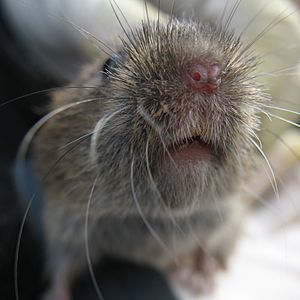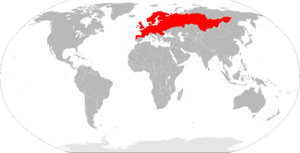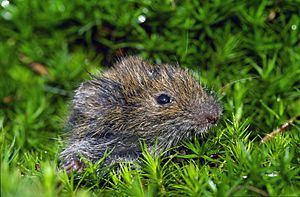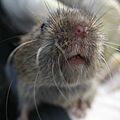Short-tailed field vole facts for kids
Quick facts for kids Short-tailed field vole |
|
|---|---|
 |
|
| Conservation status | |
| Scientific classification | |
| Genus: |
Microtus
|
| Species: |
agrestis
|
 |
|
| Field vole distribution | |
| Synonyms | |
|
|
Meet the short-tailed field vole! This small, grey-brown rodent is also known as the field vole (Microtus agrestis). It's about 10 centimeters (4 inches) long and has a short tail. It's one of the most common mammals in Europe, living from the Atlantic coast all the way to Lake Baikal in Asia.
You can find them in wet, grassy places like woodlands, marshes, or near rivers. Even though they can dig shallow burrows, they often build their nests above ground. Field voles are a key food source for owls and other animals. Their numbers go up and down in a cycle. These voles have many babies, mostly in summer, but sometimes all year long, even under snow! A female can have up to seven litters a year. Each litter has about four to six young. The babies are ready to leave their mother after about two weeks. Because they are so common and found in many places, the IUCN lists the short-tailed field vole as "Least Concern".
Contents
What Does a Field Vole Look Like?
The short-tailed field vole is a small, dark brown rodent. It has a short tail. You can tell it apart from its close relative, the common vole, by its darker, longer, and shaggier fur. Its ears also have more hair.
Its head and body are usually between 8 and 13 centimeters (3 to 5 inches) long. The tail is much shorter, about 3 to 4 centimeters (1 to 1.5 inches). These voles weigh between 20 and 50 grams (0.7 to 1.8 ounces). They make a soft, low squeak and also chatter.
Where Do Field Voles Live?
The short-tailed field vole lives across a huge area called the Palearctic region. This includes all of Western Europe. Their home stretches east to Lake Baikal in Siberia and northwest China. They also live north in Norway, Sweden, and Finland.
They are not found in Iceland. Their numbers become fewer as you go south towards the Mediterranean Sea. In 2022, they were found in Ireland for the first time. You can find them in many different places. These include meadows, field edges, forests, clearings, and even sand dunes. They like wet areas like marshes, bogs, and river banks. They can live at high places, up to about 1,700 meters (5,600 feet) high.
How Do Field Voles Behave?
Short-tailed field voles are more active during the day than common voles. They dig shallow burrows just under the ground. They also make paths through tall plants. These paths help them quickly run back to safety if there's danger. Along these paths, they often have special spots where they leave droppings. You might also see small piles of chopped grass nearby.
Field voles are herbivores, meaning they eat plants. They munch on grasses, herbs, roots, and moss. In winter, when food is scarce, they might even chew on tree bark. They do not hibernate. Sometimes, they eat small bugs like insect larvae. They especially like certain grasses, clover, dandelions, and buttercups. Voles try to pick plants that are easy to digest. They avoid some common plants that grow around them.
Voles have very low energy reserves. This means they can only go without food for about 5 to 14 hours. In winter, when there's less food, dry areas can't support many voles. But when spring arrives and food becomes plentiful, their numbers grow very quickly!
Field voles are a very important food source for many animals. Barn owls, kestrels, other owls, weasels, stoats, foxes, and snakes all hunt them. Even though there are many voles, they usually don't bother people. However, in years when their population explodes, they can sometimes damage crops.
Reproduction and Life Cycle
Field voles are induced ovulators, which means the female releases eggs after mating. They can have babies all year long. However, they have the most babies in spring and summer. The mother builds a nest on or just under the ground. It's often hidden in a clump of grass.
The babies grow inside the mother for about three weeks. A mother can give birth to up to twelve young at a time. The babies grow fast! They drink milk for about twelve days. They leave the nest when they are about three weeks old. Soon after, they are old enough to have their own babies.
Like the common vole, the short-tailed field vole can have huge population booms when conditions are just right. Females can get pregnant again very soon after giving birth. Almost all females are pregnant in late spring. This number drops in midsummer but goes up again later. About 20% of babies die in the nest. This can go up to 50% in midsummer when food is harder to digest. Field voles usually live for about two years. However, voles born in spring often live shorter lives than those born later in the year.
Male field voles usually have their own territory. Females have a home range that might overlap with other females. When young female voles leave the nest, they often stay near their mother's home range. But young males are forced to move away by the older, stronger males. Female field voles sometimes move to a new spot between having one litter and the next. This is a special behavior for this species.
One reason for the big ups and downs in field vole numbers is something called scramble competition. This happens when the best food plants are harder to find in midsummer. At these times, mothers might have fewer babies. The babies might grow slower. More young voles might die in the nest. Adult voles can lose weight, and some might even die. Similar competition can happen in winter. If there isn't enough green food, voles can starve.
Status of the Field Vole
The short-tailed field vole is common across most of its very large home range. However, there are fewer of them at the edges of their range. They might also be rare in places where the conditions are not good for them. Their total population seems stable over a long time. But their numbers can change a lot from year to year. Because of this, the IUCN has listed the short-tailed field vole as being of "Least Concern" on its Red List of Threatened Species.
Images for kids
See also
 In Spanish: Topillo agreste para niños
In Spanish: Topillo agreste para niños





